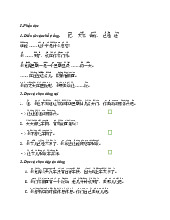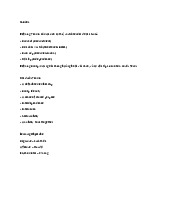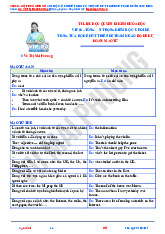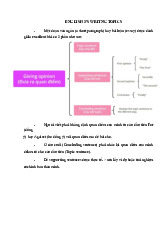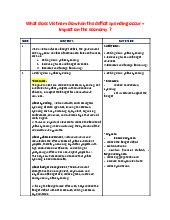













Preview text:
lOMoARcPSD|49830739 Date of teaching Class 10A1 10A2 10A3 PERIOD: REVIEW 4 Lesson 1: Language I. OBJECTIVES
By the end of this lesson, students will be able to: 1. Knowledge
- Pronunciation: Sentence stress and rhythm
- Vocabulary: Words and phrases related to the topics students have learnt in units 9, 10:
"Protecting the environment" and "Ecotourism"
- Grammar: Reported speech and the conditional type 1,2 2. Competences
- General competences: Teamwork and independent working, interactive skills, and self– study. - Specific competences:
+ Identify sentence stress and rhythm
+ Using correct words in context.
+ Using reported speech and the conditional type 1,2 in appropriate context. 3. Personal qualities
Diligence, flexibility, sense of responsibility towards their study. II. MATERIALS - Grade 10 textbook, Review 4
- Computer connected to the Internet
- Projector / TV/ pictures and cards
- Phần mềm tương tác hoclieu.vn III. PROCEDURES 1. WARM-UP (5 mins) a. Objectives:
- To revise the vocabulary related to the topic of Unit 9 and Unit 10. b. Content:
- Miming game: Students guess the word using the clue given. The
results are the words that they have learnt in 2 units. c. Expected outcomes: lOMoARcPSD|49830739
- Students can recall the important new words that they have learnt.d. Organization
TEACHER’S AND STUDENTS’ CONTENTS ACTIVITIES
MINI GAME: MATCH A WORD WITH A Answers: PICTURE
global warming, national park, -
Divide 2 teams and tell students the
ecosystem, endanger animals rules of the game -
T shows the pictures with word or
phrasal words to students. - Introduces the lesson e. Assessment
- Teacher observes the groups and give feedback.
2. ACTIVITY 1: PRONUNCIATION (12 mins) a. Objectives:
- To help students review sentence tress and practice with a natural rhythm b. Content:
- Mark the stressed syllables in the words in bold. (p.120) c. Expected outcomes:
- Students can mark the stressed syllables in the words.d. Organization
TEACHER’S AND STUDENTS’ CONTENTS ACTIVITIES
Mark the stressed syllables in the words in bold. Listen and repeat, paying
attention to the rhythm. (10 mins) -
Teacher asks students to read the sentences * The answers:
andmark the stressed syllables in the words in
1. I ‘like ‘trekking in the
bold - Students read the sentences and mark the ‘mountains
stressed syllables in the words in bold
2. The ‘children are ‘looking -
Teacher plays the recording and has students ‘forward to the ‘boat ‘trip
check their answers. Teacher checks their answers 3. Are you going to ‘visit the as a class.
mu’seum to’morrow? -
Students listen to the tape and give their
4. Don’t ‘litter while you are on the answers. ‘ecotour
-Teacher plays the recording again, pausing after
each sentence for students to repeat as naturally as possible. -
Students listen again and explain the answers
Audio script – Track … & key: lOMoARcPSD|49830739
Extension: For good students: Teacher asks students to mark the intonation pattern of
each sentence using falling and rising arrows. Then asks different questions about items
1,2 and 4: Where do you enjoy trekking? What are the children looing forward to?
Teacher asks students to repeat the questions and answer them with appropriate
intonation, using their hands to indicate the tones, e.g, lowering their hands for a falling
tone, and raising them for a rising tone. e. Assessment
- Teacher checks students’ pronunciation and gives feedback.
- Students in class listen and give feedback on their friends’ performance.
3. ACTIVITY 2: VOCABULARY (14 mins) a. Objectives:
- To help students review phrases related to the topic environment and ecotourism from Units 9-10.
- To help students further practice the use of the words related to the topic environment
and ecotourism. b. Content:
- Task 1. Complete the sentences using the phrases in the box. (p. 120) - Task 2.
Choose the correct word or phrase to complete each of the following sentences(p. 120) c. Expected outcomes:
- Students understand the meaning of words, memorise them and use them in
meaningful context. d. Organization
TEACHER’S AND STUDENTS’ ACTIVITIES CONTENTS
Task 1: Complete the following sentences using the phrases from the box . (7 mins) -
Teacher has students do this activity
KEY: 1. c 2. e 3. b 4. d
individuallyand the share their answers with a partner 5. a -
Students do this activity individually and the
sharetheir answers with a partner -
Teacher calls one student to write the answers onthe board. -
Student to write the answers on the board. -
Teacher checks the answers with the whole class. - Students listen to teacher -
Teacher confirms the correct answer.
Task 2: Choose the correct word or phrases to complete each of the following sentences.(7 mins) lOMoARcPSD|49830739
- Teacher has Ss work in pairs; tells them to read the
sentences carefully and decides which word in the KEY:
box can be used to complete each of the sentences. T 1.ecosystem
explains that they should use the context clues to 2.eco-friendly decide on the word / phrase. 3. ecotourism
- Students read the sentences carefully and decides 4. biodiversity which word in the box 5. litter
- Teacher checks answers as a class. T asks Ss to give
reasons why they have chosen the word for each
sentence, e.g. what context clues they have used. -
Students answer and explain their options
- Teacher explains and give the correct answers. - Students listen to teacher
- Teacher asks some Ss to read the complete sentences. e. Assessment
- Teacher observation on Ss’ performance.
- Teacher’s feedback and peers’ feedback.
4. ACTIVITY 3: GRAMMAR (13 mins) a. Objectives:
- To help students revise the use of reported speech and the conditional type 1, 2 b. Content:
- Task 1. Change these sentences into reported speech. (p.121) - Task 2.
Match the two parts to make complete sentences. (p.121) c. Expected outcomes:
- Students know how to use of reported speech and the conditional type 1, 2 d. Organization
TEACHER’S AND STUDENTS’ ACTIVITIES CONTENTS
Task 1. Change these sentences into reported speech. (7 mins) lOMoARcPSD|49830739 -
Teacher elicits when we use reported speech KEY:
and what changes we make when we convert direct
1. My brother said he was doing speech to reported speech.
research on sustainable tourism. -
Students use reported speech and what changes 2.Minh asked Nam if/ whether he
they make when they convert direct speech to reported liked watching programmes about speech. wildlife and nature. -
Teacher asks sts to work individually.
3. Hoa asked Mr Smith what they - Students work individually
could /can do to reduce the impact -
Teacher asks students to compare their answers of global warming on the in pairs. environment. -
Students to compare their answers in pairs.
4.The club’s secretary said they -
Teacher calls on some students to read aloud
were going to organize a lot of their
sentences or call on some sts to write their answers on activities during earth hour that the board. year. -
Students to write their answers on the board.
5. The teacher explained that the -
T gives feedback and confirms the correct
animals would/ will not survive
answers- Students listen to teacher
extreme cold weather in the North
Task 2. Match the two parts to make complete sentences. (6 mins)
-Teacher elicits the structure and use of conditional Answer key: sentences type 1,2 1.d - Students listen to teacher 2. a
-Teacher asks students to do the exercise individually 3. c - Students work individually 4. e
-Teacher has students compare their answers in pairs 5. b
- Students to compare their answers in pairs. -
Teacher call on some students to read their
sentencesaloud or write them on the board -
Students to write their answers on the board.
-Teacher checks answers as a class - Students listen to teacher e. Assessment
- Teacher observation on Ss’ performance.
- Teacher’s feedback and peers’ feedback.4. CONSOLIDATION (3 mins) a. Wrap-up
- T asks Ss to talk about what they have learnt in the lesson.b. Homework - Do exercises on workbook.
- Prepare for Review 4. Lesson 2. Listening and Speaking. lOMoARcPSD|49830739
Date of teaching Class Absentees 10A2 10A3 10A4 PERIOD: REVIEW 4
Lesson 2: Skills (1) - Listening & Speaking I. OBJECTIVES
By the end of this lesson, students will be able to: 1. Knowledge
- Review the Listening and Speaking skills they have learnt in Unit 9 and 10. 2. Competence
- Develop critical thinking skill.
- Be collaborative and supportive in pair work and team work.
- Actively join in class activities.
3. Personal qualities - Develop self-study skills. II. MATERIALS - Grade 10 textbook
- Computer connected to the internet - Pictures, A0 paper - Projector/ TV
- Phần mềm tương tác hoclieu.vn III. PROCEDURES 1. WARM-UP (5 mins) a. Objectives:
- To give excitement to students and lead in the lesson.b. Content:
- Watch a video and answer t’s question. c. Expected outcomes:
- Ss can listen for comprehension and answer the given
questions. d. Organisation
TEACHER’S AND STUDENTS’ ACTIVITIES CONTENTS lOMoARcPSD|49830739 -
T plays the video of travel plans. T-S 5
mins - Ss watch the video and write down the main ideas. -
T and Ss discuss the contents of the video. -
T confirms the answers and leads in the lesson.
Link: https://www.youtube.com/watch? v=ePtKgkMVtOc -
T asks Ss to watch a short video and try to
remember the information in the video. -
After the Ss listen, teacher shows the
question.- Ss raise their hands to grab the chance to answers. -
T checks if the answers are correct or
incorrect and leads in the lesson. - Ss listen to the teacher e. Assessment
- T observes the students and gives feedback.
2. ACTIVITY 1: LISTENING (18 mins) a. Objectives:
- To practise listening for main ideas and specific informationb. Content:
- Task 1. Listen and choose the best title for the talk.(p.122)
- Task 2. Listen again and fill in each blank with no more than 2 words.(p.122) c. Expected outcomes:
- Ss can understand the main ideas of the listening passage and solve the exercises successfully. d. Organisation
TEACHER’S AND STUDENTS’ CONTENTS ACTIVITIES
Task 1. Listen and choose the best title for the talk. (9 mins) -
T asks Ss if they remember what body- Answer key:
shamingis. Tell them that they are going to listen A
to a talk show about body-shaming. -
T asks Ss to read the ideas (A-D) and put
them in the order that they appear on the recording.
Remind them that there is ONE extra option. lOMoARcPSD|49830739 - Ss listen to the teacher -
T plays the recording for Ss to listen and number the points. -
T asks Ss to exchange the answers with yourpartner. -
Ss exchange the answers with your
partner.- Teacher asks students to report their
answers in front of the class, give the cues to support their answers -
T asks Ss to give comment your friend’s
result- Students to report their answers in front of the class -
T checks answers as a class and gives feedback. - Ss listen to the teacher
Task 2. Listen again and fill in each blank with no more than 2 words. (9 mins) -
Teacher asks students to look at the notes Answer keys:
anddecide what kind of information they need to
1. 8 2. house 3. local family fill in the blank. s 4. pagoda 5. litter
For example: 1: Number, 2: noun/ noun phrase,
3: noun/ noun phrase, 4: noun/ noun phrase… - Ss listen to the teacher -
T plays the recording again and has
studentswrite down their answers on their
notebooks. - Students listen to the tape and write down their answers -
T asks Ss to work in pairs to compare theanswers -
Ss work in pairs to compare the answers -
T has Ss report the answers in front of the
classand give the cues to support the answers - T checks answers as a class
Extension: T puts Ss into groups. Write one or
two words from each sentence of the recording
on the board. T plays the audio and have groups
try to complete each sentence with as many words as they can.
Audio script Hello everybody. This Saturday we’re all going on a trip to an ancient village
just outside the city and I’d just like to give you some information about the trip. We’re
leaving from here at 8.30 in the morning. It’s an 8-hour trip so we’ll probably be back at
8.30 p.m. We’re going to visit three of the most famous attractions in the village. This first lOMoARcPSD|49830739
one is a large ancient house. It was built 6000 years ago and its architecture is very
impressive. After that we’re going to have lunch with a local family. The family is going
to prepare the most delicious locally food for us and I’m sure we’ll enjoy it. I think
we’llstay there about 45 minutes. Then we’re going to walk to the third attraction-the
village pagoda. It’s one of the oldest and biggest pagodas in the country and is surrounded
by different types of trees. We can walk around the pagoda and learn about its interesting
history. The pagoda is very beautiful you can take some excellent photograghs there. So
don’t forget to bring your camera with you. And remember: Don’t drop litter or bick
flowers on the roadside while you are visiting the places. e. Assessment
- T checks students’ work and gives feedback.
- Ss in class listen and give feedback on their friends’ performance.3.
ACTIVITY 2: SPEAKING (19 mins) a. Objectives:
- To help Ss develop ideas for the speaking task.
- To give Ss an opportunity to take part in a group discussion, then report their
discussion to the whole class. b. Content:
- Imagine they are going on a day trip. Work in pairs. Discuss and plan your trip. (p.122) c. Expected outcomes:
- Ss come up with good ideas and good ways to deal with plan your trip. d. Organisation
TEACHER’S AND STUDENTS’ CONTENTS ACTIVITIES
Imagine they are going on a day trip. Work in pairs. Discuss and plan your trip. (9 mins) -
T puts Ss in pairs. T asks them to imagine
Students’ performance
they are going on a day trip and need to plan its itineraries. - Ss listen to the teacher -
T explains that this could be a real or an imaginary place. lOMoARcPSD|49830739 -
Before they start, quickly review different
techniques for starting, maintaining, and
concluding a conversation or discussion by
writing on the board some key communication
strategies and eliciting useful expressions, e.g.
Can you tell me one way to start a conversation?
When we end a conversation, what should we do?
- T encourages Ss to use the expressions when
they discuss the questions in pairs. -
Ss work in pairs to discuss the answers -
T walks around and provides help if
necessary.- T calls some sts to present their plans
for their a day trip in front of the class -
Students to report their answers in front of theclass - T gives feedback. - Ss listen to the teacher e. Assessment
- T observes Ss’ performance.
- T’s feedback and peers’ feedback.4. CONSOLIDATION (3 mins) a. Wrap-up
- T asks Ss to talk about what they have learnt in the lesson.b. Homework - Do exercises on workbook.
- Prepare for Review 4. Lesson 3. Reading and Writing.
Date of teaching Class Absentees 10A1 10A2 10A3 PERIOD: REVIEW 4
Lesson 3: Skills (2) - Reading and Writing I. OBJECTIVES
By the end of this lesson, students will be able to: 1. Knowledge
- Review the Reading and Writing skills they have learnt in Unit 9 and 10. lOMoARcPSD|49830739 2. Competence
- Develop critical thinking skills;
- Be collaborative and supportive in pair work and team work;- Actively join in class activities.
3. Personal qualities - Develop self-study skills. II. MATERIALS - Grade 10 textbook
- Computer connected to the internet - Pictures, A0 paper - Projector/ TV
- Phần mềm tương tác hoclieu.vn III. PROCEDURES 1. WARM-UP (5 mins) a. Objectives:
- To give excitement to students and lead in the lesson.b. Content:
- Talk about your plan for a day trip. c. Expected outcomes:
- Ss understand what is inside a national park. d. Organisation
TEACHER’S AND STUDENTS’ CONTENTS ACTIVITIES
TALK ABOUT YOUR PLAN FOR A DAY TRIP
Students’ performance -
T elicits the requirement of talking about your plan for a day trip. -
Ss listen to the teacher- Ss raise hands to answer. -
T shows the rule to all students -
T listens to student‘s answers and takes notes for comments. -
Students talking about your plan for a day trip.in front of the class. -
T provides comments and feedback. - T leads into the lesson. e. Assessment lOMoARcPSD|49830739
- T observes the students and gives feedback.
2. ACTIVITY 1: READING (18 mins) a. Objectives:
- To help Ss practise reading for main ideas.
- To help Ss practise reading for specific information.b. Content:
- Task 1. Read the text. Match the highlighted words with their meanings.(p.122) -
Task 2. Read the text again and choose the best answer. (p.123) c. Expected outcomes:
- Ss can understand the main ideas as well as specific information of the reading passage. d. Organisation
TEACHER’S AND STUDENTS’ CONTENTS ACTIVITIES
Task 1. Read the text. Match the highlighted words with their meanings. (6 mins) -
T asks students to read the whole text to Answer keys: havean overall idea. 1.b 2. a 3. c -
T asks students to read again paying
attentionto the context of each highlighted word,
then look at the 3 definitions. -
Students to read again paying attention to
thecontext of each highlighted word -
T tells sts to work in pairs to discuss
thecontext clues for each word and compare answers. -
Ss work in pairs to compare the answers -
T has Ss report the answers in front of the
classand give the cues to support the answers -
Ss report the answers in front of the class - T
checks with the whole class. T has Ss give the cues to support the answers. - Ss listen to the teacher
Task 2. Read the text again and choose the best answer. (6 mins) lOMoARcPSD|49830739 -
T asks Ss to read the three points and Answer keys: 1. checks understanding. A 2. B 3. C. -
In stronger classes, have them do the
activity first, then read the text to check their
answers. In weaker classes, do the first one as an
example and have Ss read the text again to locate the information. -
T has Ss work in groups to do it. -
Ss work in groups to compare the
answers- T asks ss to exchange the answers with
another group in order to check -
T asks them to provide evidence from the textto support each answer. -
Ss report the answers in front of the class -
T gives feedback and checks answers as aclass. - Ss listen to the teacher
e.g. 1 A (sentence 1 of the paragragh 2). Extension: (6 mins)
T devides Ss into groups. T has groups write
True/False statements about the reading text, e.g.
When people travel, they don’t affect the
environment.(False); Your carbon footprint
increases when you travelby plane.(True). Then
invite each group to read their statements while
the rest of the class say if they are true or false,
and correct the false ones. In stronger classes, ask Ss to close their books
e. Assessment- T checks students’ work and gives feedback.
- Ss in class listen and give feedback on their friends’ performance.
3. ACTIVITY 2: WRITING (19 mins) a. Objectives:
- To help Ss generate ideas for a proposal.
- To help Ss practise writing a proposal.b. Content:
Writing a paragraph(120-150 words) about things they should do and shouldn’t do to
reduce the negative impacts of travelling on the environment. (p. 123) c. Expected outcomes: lOMoARcPSD|49830739
- Ss develop writing skills on the given topic. d. Organisation
TEACHER’S AND STUDENTS’ CONTENTS ACTIVITIES
Writing a paragraph about things they should do and shouldn’t do to reduce the
negative impacts of travelling on the environment. (19 mins) -
T tells sts to read the text again and extract Sample answer
some ideas for their writing, e.g. walk, cycle, or use public transport. - Ss listen to the teacher -
T encourages sts to brainstorm additional
ideas. - T asks sts to complete the task
individually and write a paragraph then swap
their paragraphs with a partner for peer review. - Ss work individually -
T walks around the class to monitor, make
a note of common mistakes. After all sts finish
the writing task, teacher writes the mistakes on
the board and asks sts to correct the mistakes. - T
collects sts’ writing tasks and give face-toface
feedback in private, or give them some written feedback. -
Ss report the writing in front of the class- T
can give some suggested answers in weaker classes. - Ss listen to the teacher Sample answer:
There are several things that we should do to reduce the negative impact of travelling on
the environment. Firstly, we should reduce our carbon footprint during the trip. We should
only fly when the trip is long and choose the environmentally – friendly means of transport
such as cycling or public transport. Secondly, wherever we go, we should always protect
our environment. By keeping it clean and safe, we can reduce the negative impact of
travelling on the environment. e. Assessment
- Teacher observation on Ss’ performance.
- Teacher’s feedback and peers’ feedback.4. CONSOLIDATION (3 mins) a. Wrap-up
- T asks Ss to talk about what they have learnt in the lesson.b. Homework - Do exercises on workbook.
